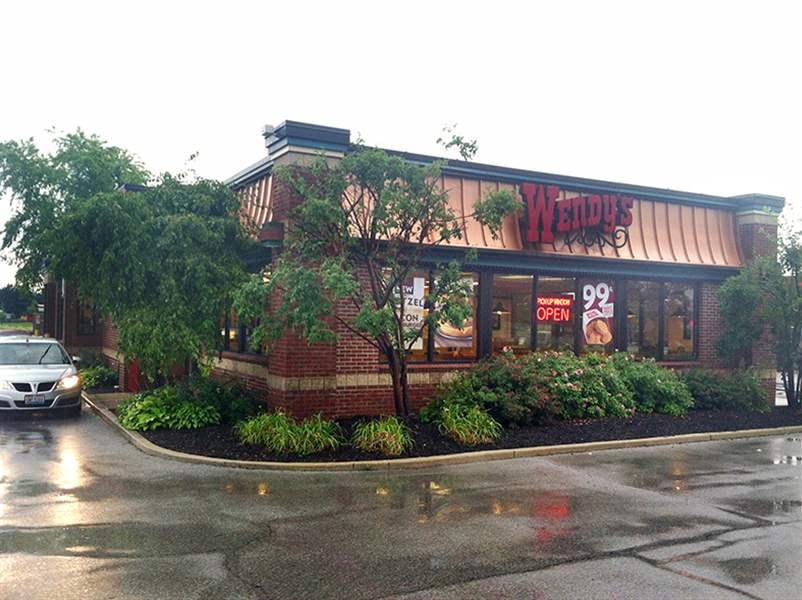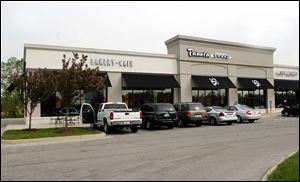
RESTAURANTS
Eateries blur lines of dining-out experience
Fast, fancy, casual not sole offerings
7/13/2013
Wendy’s at 26630 Dixie Highway in Perrysburg is the first such restaurant in the Toledo area to be getting a new company design.
THE BLADE
Buy This Image

Wendy’s at 26630 Dixie Highway in Perrysburg is the first such restaurant in the Toledo area to be getting a new company design.
ORLANDO, Fla. — Mike Parson didn’t feel as if he were in a fast-food joint at a newly renovated Orlando, Fla., Wendy’s with a lounge, faux fireplace, Wi-Fi, and separate counters for orders and pickup.
“It feels more like a hangout,” said Mr. Parson, a 22-year-old University of Central Florida student.
That’s exactly what Wendy’s was aiming for — more of a Panera Bread vibe — with its design in the restaurant, which will be used in new and remodeled restaurants from now on.
Recently, the company said, Wendy’s restaurant at 26630 Dixie Hwy. in Perrysburg will incorporate the Columbus-based company’s new design in September.
The fast-food chain has rolled out its new store design in about 100 sites around the nation, said Kitty Munger of Wendy’s marketing team.
“We’re moving a little bit toward the fast-casual,” said Craig Madanick, a Wendy’s Co. field-marketing manager. “We feel it’s necessary for us to stay competitive and gain the upper edge to offer a new environment to our consumers.”
America once had very specific kinds of restaurants. There was fast food for a quick bite, casual dining for a fun night out, and fine dining for that really special occasion. But now those lines are getting fuzzier.
As they struggled to lure more customers during the Great Recession, some chains began looking to broaden their appeal.
“The blurring is definitely occurring,” said Bonnie Riggs, restaurant analyst for the research company NPD Group. “They’re trying to find all kinds of ways to drive visits.”
Panera Bread Co. has turned to one of fast-food’s standard features: the drive-through lane.
Red Lobster is trying pay-at-the-counter service. And the Melting Pot is encouraging fondue diners to come in for something a little simpler than its elaborate four-course meal.

Panera Bread officials vowed at one time never to install drive-through lanes. But the chain has added them to 27 bakery cafes in the Orlando area and one at its Findlay store.
Fine-dining restaurants have become more casual, Ms. Riggs said, and more focused on their bar business.
Ruth’s Chris Steak House, owned by Ruth’s Hospitality Group, last year introduced a “Sizzle, Swizzle, Swirl Happy Hour” bar menu, with food costing far less than the steakhouse entrees.
The goal is to “turn many first-time, often younger, guests into Ruth’s Chris regulars,” Chief Executive Officer Mike O’Donnell told analysts last month.
Fleming’s Prime Steakhouse & Wine Bar has a “5 for $6 ’til 7” bar menu that includes baked brie and pan-crisped pork belly.
The Melting Pot has often been a spot for special occasions. But a menu makeover was meant to encourage customers to stop in for a more casual visit. The company’s Web site assures diners it’s just fine to stick with cheese and chocolate fondues rather than the pricier entrees.
“Restaurants … are really competing for every dollar, and they have to reinvent themselves,” said Sandy D’Elosua, the chain’s marketing director.
Two new categories have evolved and flourished the last few years: fast casual and polished casual. Fast-casual restaurants such as Panera Bread are a step up from fast food and a tad more expensive. Customers order and pay at the counter, but the food tends to be fresher and more sophisticated.
Polished-casual restaurants such as the Cheesecake Factory Inc., meanwhile, offer more contemporary fare and atmospheres than a typical TGI Friday’s or Olive Garden. So, as casual-dining restaurants have lost ground to their quicker, cheaper competitors, some are saying, “If you can’t beat ’em, join ’em.”
Red Lobster, owned by Darden Restaurants Inc., has begun testing “Seaside Express,” a pay-at-the-counter lunchtime option, in two Orlando-area restaurants. Applebee’s International Inc. is trying a similar concept. The lunchtime options are quicker, and there’s no obligation to tip.
Even the successful fast-casual restaurants, though, are borrowing from other categories, and it’s boosting the bottom line.
For a long time, Panera Bread took the view that “we will never have a drive-through; we don’t want to be portrayed or thought of as a fast-food type of operation,” said Gavin Ford, who owns Central Florida Panera franchises.
But that has changed. And the 27 Orlando-area bakery-cafes with drive-through lanes have seen sales jump by up to 35 percent, Mr. Ford said.
Customers “want more choices, more options,” he said. “People are just more demanding these days.”
Menus are also getting more expansive. Red Lobster last year introduced one on which nearly 25 percent of its items are not seafood — up from 8 percent previously.
But companies need to be careful, Ms. Riggs warned, not to become the proverbial jack of all trades and master of none.
After disappointing sales, Ruby Tuesday Inc. said earlier this year it was backing away from its attempts to go more upscale. And last month, McDonald’s Corp. admitted that not many customers buy its salads.
They make up only 2 percent to 3 percent of sales, and “I don’t see salads as being a major growth driver in the near future,” Chief Executive Officer Donald Thompson told investors.
“You really have to stay true to your core,” Ms. Riggs said. “Trying to be all things to all people, it’s not going to work for everybody.”